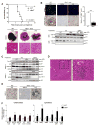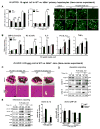Differential regulation of inflammation and apoptosis in Fas-resistant hepatocyte-specific Bid-deficient mice
- PMID: 24681344
- PMCID: PMC4712949
- DOI: 10.1016/j.jhep.2014.03.028
Differential regulation of inflammation and apoptosis in Fas-resistant hepatocyte-specific Bid-deficient mice
Abstract
Background & aims: Activation of Fas death receptor results in apoptosis in multiple organs, particularly liver, in a process dependent on Bid cleavage. Mice injected with an anti-Fas antibody die within hours of acute liver failure associated with massive apoptosis and hemorrhage. Our aim was to investigate the crosstalk of apoptotic and inflammatory pathways and the contribution of selective hepatocellular apoptosis during in vivo Fas activation.
Methods: We generated hepatocyte-specific Bid deficient mice (hBid(-/-)). Acute liver injury was induced by Fas-activating antibody (Jo2) in a time-course study.
Results: In contrast to controls, nearly all Jo2 injected hBid(-/-) survived. Their livers showed complete protection against hepatocellular apoptosis with minimal focal hemorrhagic changes and mainly non-parenchymal cell apoptosis. In agreement, the hepatocytes had no mitochondrial cytochrome c release in cytosol, or caspase 3 activation. hBid(-/-) livers showed marked increase in acute inflammatory foci composed of neutrophils and monocytes associated with the increased expression of proinflammatory chemokines and cytokines, in the manner dependent on non-canonical interleukin-1β activation and amplified in the absence of caspase-3 activation. In addition, hBid(-/-) mice were completely protected from hepatotoxicity and the infiltrated cells were cleared 2 weeks post single Jo2 injection.
Conclusions: Hepatocyte Bid suppression is critical for the resistance to the lethal effects of Fas activation in vivo. Fas signaling induces differential activation of non-canonical interleukin-1β maturation, amplified in the absence of apoptotic Bid-mitochondrial loop, in hepatocytes. These findings may have important pathophysiological and therapeutic implications in a variety of liver disorders associated with Fas activation.
Keywords: Acute liver failure; Crosstalk of inflammatory and apoptotic pathways; Fas-mediated hepatic apoptosis; Hepatoprotection; Inflammation; Non-canonical IL-1β maturation.
Copyright © 2014 European Association for the Study of the Liver. Published by Elsevier B.V. All rights reserved.
Conflict of interest statement
Figures




Similar articles
-
The strength of the Fas ligand signal determines whether hepatocytes act as type 1 or type 2 cells in murine livers.Hepatology. 2009 Nov;50(5):1558-66. doi: 10.1002/hep.23176. Hepatology. 2009. PMID: 19711425 Free PMC article.
-
Switch from type II to I Fas/CD95 death signaling on in vitro culturing of primary hepatocytes.Hepatology. 2008 Dec;48(6):1942-53. doi: 10.1002/hep.22541. Hepatology. 2008. PMID: 19003879 Free PMC article.
-
Delayed-onset caspase-dependent massive hepatocyte apoptosis upon Fas activation in Bak/Bax-deficient mice.Hepatology. 2011 Jul;54(1):240-51. doi: 10.1002/hep.24305. Epub 2011 Apr 11. Hepatology. 2011. PMID: 21425311
-
Bid, a critical mediator for apoptosis induced by the activation of Fas/TNF-R1 death receptors in hepatocytes.J Mol Med (Berl). 2000;78(4):203-11. doi: 10.1007/s001090000099. J Mol Med (Berl). 2000. PMID: 10933582 Review.
-
Tumor necrosis factor signaling in hepatocyte apoptosis.J Gastroenterol Hepatol. 2007 Jun;22 Suppl 1:S43-4. doi: 10.1111/j.1440-1746.2006.04645.x. J Gastroenterol Hepatol. 2007. PMID: 17567463 Review.
Cited by
-
Bacteroides acidifaciens in the gut plays a protective role against CD95-mediated liver injury.Gut Microbes. 2022 Jan-Dec;14(1):2027853. doi: 10.1080/19490976.2022.2027853. Gut Microbes. 2022. PMID: 35129072 Free PMC article.
-
Apoptotic cell death in disease-Current understanding of the NCCD 2023.Cell Death Differ. 2023 May;30(5):1097-1154. doi: 10.1038/s41418-023-01153-w. Epub 2023 Apr 26. Cell Death Differ. 2023. PMID: 37100955 Free PMC article. Review.
-
Liver Bid suppression for treatment of fibrosis associated with non-alcoholic steatohepatitis.J Hepatol. 2016 Mar;64(3):699-707. doi: 10.1016/j.jhep.2015.11.002. Epub 2015 Nov 7. J Hepatol. 2016. PMID: 26555271 Free PMC article.
-
Transmembrane BAX Inhibitor motif-containing 1, a novel anti-inflammatory approach for nonalcoholic steatohepatitis treatment.Hepatology. 2018 Jan;67(1):438-441. doi: 10.1002/hep.29495. Hepatology. 2018. PMID: 28859227 Free PMC article. No abstract available.
-
Bid-deficient fish delay grass carp reovirus (GCRV) replication and attenuate GCRV-triggered apoptosis.Oncotarget. 2017 Jul 22;8(44):76408-76422. doi: 10.18632/oncotarget.19460. eCollection 2017 Sep 29. Oncotarget. 2017. PMID: 29100321 Free PMC article.
References
-
- Suda T, Takahashi T, Golstein P, Nagata S. Molecular cloning and expression of the Fas ligand, a novel member of the tumor necrosis factor family. Cell. 1993;75:1169–78. - PubMed
-
- Ogasawara J, Watanabe-Fukunaga R, Adachi M, Matsuzawa A, Kasugai T, Kitamura Y, et al. Lethal effect of the anti-Fas antibody in mice. Nature. 1993;364:806–9. - PubMed
-
- Itoh N, Yonehara S, Ishii A, Yonehara M, Mizushima S, Sameshima M, et al. The polypeptide encoded by the cDNA for human cell surface antigen Fas can mediate apoptosis. Cell. 1991;66:233–43. - PubMed
-
- Nagata S. Apoptosis by death factor. Cell. 1997;88:355–65. - PubMed
Publication types
MeSH terms
Substances
Grants and funding
LinkOut - more resources
Full Text Sources
Other Literature Sources
Molecular Biology Databases
Research Materials
Miscellaneous

